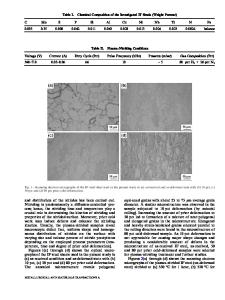Tribology and Surface Mechanical Properties of Excimer Laser Nitrided Titanium
- PDF / 1,390,462 Bytes
- 6 Pages / 414.72 x 648 pts Page_size
- 63 Downloads / 346 Views
ABSTRACT We have nitrided Ti-6A1-4V alloys using excimer laser pulses at 1.2 J-rcm 2 in high purity N2 at approximately one atmosphere. Substantial nitrogen and oxygen incorporation resulted from multiple pulse processing. The surface microstructure that results is of fine grained precipitates in the Ti alloy matrix. Formation of a TiN surface film was not observed. We have examined the tribological and mechanical properties of these surfaces using pin-on-disk and nanoindenter techniques respectively. Nitrogen alloying results in a period of reduced friction and torque noise in the pin-on-disk measurements. At higher N concentrations, abrasive wear of the pin is observed, but with little deterioration of the disk surface. This is consistent with the formation of a transfer film at the sliding interface. Nanoindenter measurements of the surfaces show increasing hardness proportional to nitrogen incorporation. The tribological properties can therefore be understood to result from a combination of tribochemical effects and increased surface hardness. INTRODUCTION Titanium alloys are widely used in applications which require a high strength to weight ratio at relatively high temperatures (up to 300 C), as well as in surgical prostheses on account of their biocompatibility' . However, Ti alloys are also known for their poor tribomechanical properties and as a result, numerous surface modification techniques have been applied in order to increase wear resistance of the alloy's surface. In particular, laser techniques have focused on treatment of Ti alloys in a nitrogen or ammonia atmosphere .3 45' 6 . These have relied on infrared (IR) laser energy, generally from either CO 2 or Nd-YAG lasers, as these are standard industrial lasers used for a number of surface modification processes 7. These methods produce a thick TiN surface layer, which is indeed quite hard. However, much of the incident energy of these lasers is wasted as Ti is a good reflector at these wavelengths. Excimer lasers, using an ultraviolet wavelength at which coupling between the laser light and the metal surface is quite strong, have also been used to create a TiN surface layer, but under processing conditions in which the Ti surface remains molten between laser pulses 8. Nitrogen ion implantation of Ti alloys has also increased 9,hardness of TiN particles in the a1%,11,1Z,1314 and improved wear behavior throughprecipitation V3 Ti matrix9 1 and formation of a TiN surface layer . We have studied the alteration of surface properties of Ti alloys using excimer laser radiation at low repetition rates. At these rates, the surface cools fully between pulses and each pulse can be considered independent. Thus phase formation is determined in large part by the rapid solidification and cooling (-10'0 K-s') experienced by the sample1 . In previous work we processed the surface in air and found extensive oxygen incorporation into the surface and precipitation of TiO (y phase) particles17. We observed substantial surface hardening of Ti-6AI4V from solution and prec
Data Loading...











